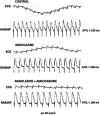Effects of Ranolazine and its Combination with Amiodarone on Rapid Pacing-induced Reentrant Atrial Tachycardia in Rabbits
- PMID: 33777481
- PMCID: PMC7987427
- DOI: 10.19102/icrm.2021.120304
Effects of Ranolazine and its Combination with Amiodarone on Rapid Pacing-induced Reentrant Atrial Tachycardia in Rabbits
Abstract
Ranolazine (RAN) has previously been shown to lower the onset of cholinergic atrial fibrillation in intact animals; however, its efficacy in the setting of atrial tachycardia (AT) is unknown. The purpose of this study was to investigate the effects of RAN alone or in combination with amiodarone (AMIO) on rapid pacing-evoked right AT in rabbit hearts. Right atrial monophasic action potentials (MAPs) were recorded in 11 anesthetized rabbits, using combination MAP pacing catheters. Vulnerability to AT was tested by employing consecutive trains of rapid burst pacing prior to and after 2.4 mg/kg of RAN alone delivered intravenously and then in combination with 3 mg/kg of AMIO as a 15-minute infusion. Primary endpoints were postdrug AT reproducibility as well as cycle length (CL) and tachycardia duration. MAP duration at 75% repolarization and the effective refractory period (ERP) were assessed during programmed pacing to calculate the atrial postrepolarization refractoriness (aPRR = ERP - MAPD75%). AT was elicited in eight out of 11 rabbits; only these animals were included for further investigation. RAN did not abolish the inducibility of AT in any experiment; however, it prolonged its CL (baseline vs. RAN: 120 ± 16 ms vs. 138 ± 18 ms; p = 0.053). Supplemental AMIO further increased the AT CL (baseline vs. RAN + AMIO: 120 ± 16 ms vs. 152 ± 23 ms; p = 0.006), without affecting arrhythmia reinducibility. Slowing of the tachycardia after RAN or RAN + AMIO was associated with spontaneous termination of the arrhythmia. RAN prolonged the aPRR significantly, while AMIO in addition to RAN potentiated this effect. Neither RAN alone nor its combination with AMIO abolished the elicitation of AT in this model. However, both agents synergistically prolonged the aPRR, resulting in the slowing of AT and promoting spontaneous termination of the arrhythmia.
Keywords: Amiodarone; atrial pacing; atrial tachycardia; rabbit heart; ranolazine.
Copyright: © 2021 Innovations in Cardiac Rhythm Management.
Conflict of interest statement
The authors report no conflicts of interest for the published content.
Figures




Comment in
-
"Ranolaziodarone"-A Synergism You Should Not Miss.J Innov Card Rhythm Manag. 2021 Mar 15;12(3):4429-4431. doi: 10.19102/icrm.2021.120303. eCollection 2021 Mar. J Innov Card Rhythm Manag. 2021. PMID: 33779663 Free PMC article. No abstract available.
References
-
- Saoudi N, Cosio F, Waldo A, et al. Classification of atrial flutter and regular atrial tachycardia according to electrophysiologic mechanism and anatomic bases: a statement from a Joint Expert Group from the Working Group of Arrhythmias of the European Society of Cardiology and the North American Society of Pacing and Electrophysiology. J Cardiovasc Electrophysiol. 2001;12(7):852–866. [CrossRef] [PubMed] - DOI - PubMed
-
- Knecht S, Veenhuyzen G, O’Neill MD, et al. Atrial tachycardias encountered in the context of catheter ablation for atrial fibrillation part ii: mapping and ablation. Pacing Clin Electrophysiol. 2009;32(4):528–538. [CrossRef] [PubMed] - DOI - PubMed
-
- Patel A, Markowitz SM. Atrial tachycardia: mechanisms and management. Expert Rev Cardiovasc Ther. 2008;6(6):811–822. [CrossRef] [PubMed] - DOI - PubMed
-
- Zygmunt AC, Nesterenko VV, Rajamani S, et al. Mechanisms of atrial-selective block of Na⁺ channels by ranolazine: I. Experimental analysis of the use-dependent block. Am J Physiol Heart Circ Physiol. 2011;301(4):H1606–H1614. [CrossRef] [PubMed] - DOI - PMC - PubMed
-
- Burashnikov A, Pourrier M, Gibson JK, Lynch JJ, Antzelevitch C. Rate-dependent effects of vernakalant in the isolated non-remodeled canine left atria are primarily due to block of the sodium channel: comparison with ranolazine and dl-sotalol. Circ Arrhythm Electrophysiol. 2012;5(2):400–408. [CrossRef] [PubMed] - DOI - PMC - PubMed
LinkOut - more resources
Full Text Sources
Other Literature Sources
Miscellaneous
